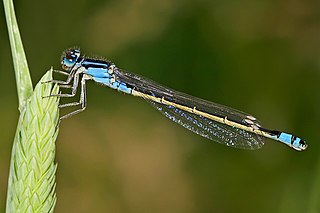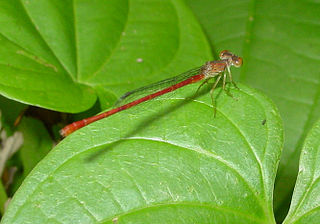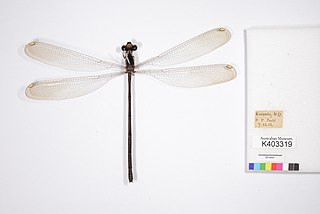Chlorocypha is a genus of damselflies in the family Chlorocyphidae.
Coenagriocnemis is a genus of damselfly in the family Coenagrionidae. The whole genus is endemic to the Mascarene Islands.
Diastatomma is a genus of dragonfly in the family Gomphidae. It contains the following species:

Gynacantha is a genus of dragonflies in the family Aeshnidae. The females have two prominent spines under the last abdominal segment. This gives the genus name and the common name two-spined darners; they are also known as duskhawkers.

Heliogomphus is a genus of dragonflies in the family Gomphidae.

Ischnura is a genus of damselflies known as blue tails in the family Coenagrionidae. Forktails are distributed worldwide, including various oceanic islands. The males have a forked projection at the tip of the abdomen which gives the group their common name.

Macromia is a genus of large dragonflies in the family Macromiidae. They are commonly known as river cruisers from their habit of cruising long distances along river banks. Most species of Macromia occur in the tropical Australasian region, with one species being found in Europe , and a few species occurring in North America.

Onychogomphus is a genus of dragonflies in the family Gomphidae. They are commonly known as Pincertails.

Paragomphus is a genus of dragonfly in the family Gomphidae. They are commonly known as Hooktails.
Phyllogomphus annulus is a species of dragonfly in the family Gomphidae. It is found in Angola, the Democratic Republic of the Congo, and Uganda. Its natural habitats are subtropical or tropical moist lowland forests and intermittent rivers.
Phyllogomphus selysi is a species of dragonfly in the family Gomphidae. It is found in Angola, Botswana, Cameroon, the Republic of the Congo, the Democratic Republic of the Congo, Kenya, Malawi, Mozambique, Namibia, South Africa, Tanzania, Uganda, Zambia, Zimbabwe, and possibly Burundi. Its natural habitat is rivers.

Phyllomacromia a large genus of dragonflies in the family Macromiidae. They are commonly known as cruisers.

Platycypha is a genus of African damselflies in the jewel damselfly family (Chlorocyphidae).

Zygonyx is a genus of dragonflies in the family Libellulidae. They are commonly known as cascaders because of their preference for living beside waterfalls and flying through the spray. They lay their eggs into the wet dangling roots of plants.

Idionyx is a genus of dragonflies in the family Synthemistidae, which is earlier treated as a subfamily of Corduliidae. According to World Odonata List, this genera is best considered incertae sedis.

Anax is a genus of dragonflies in the family Aeshnidae. It includes species such as the emperor dragonfly, Anax imperator.

Telebasis is a genus of damselflies in the family Coenagrionidae. The genus occurs in the Neotropics. Most of the species are red with a few blue species in South America.

Podopteryx selysi is a species of Australian damselfly in the family Megapodagrionidae, commonly known as a treehole flatwing. It can be found in coastal northern Australia and New Guinea, where its larvae live in water-filled holes in tree trunks in rainforest.

Synlestes selysi is a species of Australian damselfly in the family Synlestidae, commonly known as a forest needle. It is endemic to eastern New South Wales and eastern Queensland, where it inhabits streams.
Chlorocypha selysi is a species of jewel damselfly in the family Chlorocyphidae.














